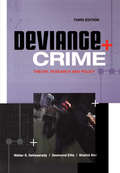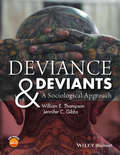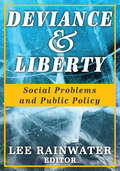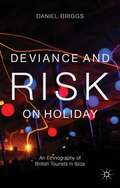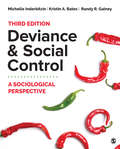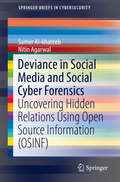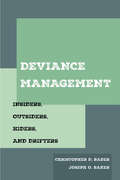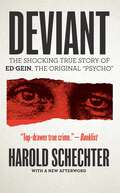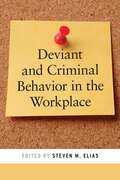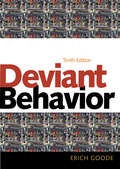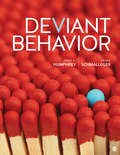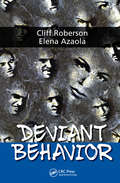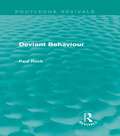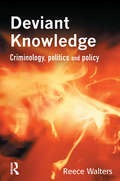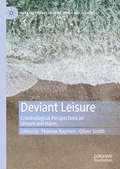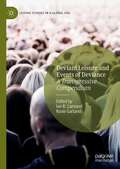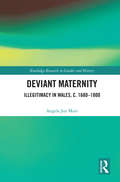- Table View
- List View
Deviance and Control: The Secular Heresy (Routledge Revivals)
by Terence MorrisIn the early 1970s many sociologists, particularly radical theorists of crime and deviance, had rejected the belief that sociological knowledge was objective or value-free. Their work, often with good reason, had come to dominate much of the literature of criminology, deviance and social work. In this book, originally published in 1976, Professor Morris provided an immensely readable and controversial reply. At the time it was felt it was likely to please neither the materialist nor the positivist, and that those whose master was not Marx but Freud would find little comfort in it. Though he writes as a social scientist, the book is not weighed down by statistics, nor an endless, jargon-laden exegesis of criminological and deviance theory. What it does do is to set the question of deviance and its control in a wider perspective by examining our beliefs about social order at the time and the manner in which such order was imposed. In doing so, the author draws widely upon history, sociology and philosophy, providing essential reading for students of sociology, crime and deviance, social work and the law.
Deviance and Crime: Theory, Research and Policy
by Shahid Alvi Walter S. Dekeseredy Desmond EllisThis book sensitizes the reader to the fact that there is substantial disagreement within the academic community, and among policymakers and the general public, over what behaviors, conditions (e.g., physical attributes), and people should be designated as deviant or criminal. Normative conceptions, the societal reaction/labeling approach, and the critical approach are offered as frameworks within which to study these definitions. A comprehensive explanation of theory and social policy on deviance is constructed.
Deviance and Deviants: A Sociological Approach
by William E. Thompson Jennifer C. GibbsThis comprehensive and engaging textbook provides a fresh and sociologically-grounded examination of how deviance is constructed and defined and what it means to be classed a deviant. Covers an array of deviances, including sexual, physical, mental, and criminal, as well as deviances often overlooked in the literature, such as elite deviance, cyber-deviance, and deviant occupations Examines the popular notions and pseudoscientific explanations upon which the most pervasive myths surrounding deviance and deviants are founded Features an analytical through-line assessing the complex and multifaceted relationship between deviance and the media Enhanced with extensive pedagogical features, including a glossary of key terms, lists of specific learning outcomes in each chapter, and critical thinking questions designed to assess those outcomes Comprehensive instructor ancillaries include PowerPoint slides, a test bank for each chapter, instructor outlines, and sample activities and projects; a student study guide also is available
Deviance and Liberty: Social Problems and Public Policy
by Lee RainwaterDeviance is by definition a social problem. Since deviant behavior violates the normative expectations of a given group, deviance must be regarded as a problem for that group, since all groups of people want their norms to be enforced. Many modern societies place considerable value on personal liberty, so much so that interference with personal choices to deviate from group norms can be justified only in terms of the potential damage that particular kinds of behavior might do to the legitimate interests of others. Sociological research suggests that the social problem associated with deviance is often the behavior of individuals who violate norms cannot be justified in terms of basic values of liberty, social order, or justice. In other kinds of deviance, though, the social problem is that people or, in a more organized way, social institutions, interfere with individual liberty and self-realization. Each selection in this volume has been chosen to cover a full range of substantive problematic issues, a range of social science perspectives that can be brought to bear on issues of all kinds, and a range of social science methodologies used in studying modern society. 'Deviance and Liberty' is divided up into thirty-nine contributions and five main parts ranging from "Modern Perspectives on Deviance and Social Problems"; "Deviant Exchanges: Gambling, Drugs, and Sex"; "Deviant Personal Control: Illness, Violence, and Crime; Deviance, Identity, and the Life Cycle"; and "Moral Enterprise and Moral Enforcement." It is a welcome addition to the libraries of those interested in the study of deviance or society as a whole.
Deviance and Risk on Holiday
by Daniel BriggsThis book represents the first attempt to step inside the holiday experience of young British tourists in San Antonio, Ibiza. Briggs' ethnographic study reveals the ugly truth about how and why they get involved in deviance and risk-taking when they go abroad, driven by self validation and a commodified social context.
Deviance and Social Control: A Sociological Perspective
by Randy R. Gainey Michelle L. Inderbitzin Dr Kristin BatesDeviance and Social Control: A Sociological Perspective, Second Edition serves as a guide to students delving into the fascinating world of deviance for the first time. Authors Michelle Inderbitzin, Kristin A. Bates, and Randy Gainey offer a clear overview of issues and perspectives in the field, including introductions to classic and current sociological theories as well as research on definitions and causes of deviance and reactions to deviant behavior. The unique text/reader format provides the best of both worlds, offering both substantial original chapters that clearly explain and outline the sociological perspectives on deviance, along with carefully selected articles on deviance and social control taken directly from leading academic journals and books. The Second Edition features updated research, examples of specific forms of deviance, and discussions of policy, as well as a new chapter and readings on global perspectives on deviance and social control.
Deviance and Social Control: A Sociological Perspective
by Randy R. Gainey Michelle L. Inderbitzin Kristin A. BatesDeviance and Social Control: A Sociological Perspective provides a sociological examination of deviant behavior in society, with a significant focus on the major theories of deviance and society’s reaction to deviance. Authors Michelle Inderbitzin, Kristin A. Bates, and Randy R. Gainey use sociological theories to illuminate issues related to deviant behavior, offering clear overviews and perspectives in the field as well as introductions to classic and current research. A unique text/reader format combines substantial original chapters that clearly explain and outline the sociological perspectives on deviance with carefully selected articles from leading academic sources. Included with this title: The password-protected Instructor Resource Site (formally known as SAGE Edge) offers access to all text-specific resources, including a test bank and editable, chapter-specific PowerPoint® slides.
Deviance and Social Control: A Sociological Perspective
by Randy R. Gainey Michelle L. Inderbitzin Kristin A. BatesDeviance and Social Control: A Sociological Perspective provides a sociological examination of deviant behavior in society, with a significant focus on the major theories of deviance and society’s reaction to deviance. Authors Michelle Inderbitzin, Kristin A. Bates, and Randy R. Gainey use sociological theories to illuminate issues related to deviant behavior, offering clear overviews and perspectives in the field as well as introductions to classic and current research. A unique text/reader format combines substantial original chapters that clearly explain and outline the sociological perspectives on deviance with carefully selected articles from leading academic sources. Included with this title: The password-protected Instructor Resource Site (formally known as SAGE Edge) offers access to all text-specific resources, including a test bank and editable, chapter-specific PowerPoint® slides.
Deviance and Social Control: A Sociological Perspective
by Michelle L. Inderbitzin Dr Kristin Bates Randy R. GaineyDeviance and Social Control: A Sociological Perspective, Second Edition serves as a guide to students delving into the fascinating world of deviance for the first time. Authors Michelle Inderbitzin, Kristin A. Bates, and Randy Gainey offer a clear overview of issues and perspectives in the field, including introductions to classic and current sociological theories as well as research on definitions and causes of deviance and reactions to deviant behavior. The unique text/reader format provides the best of both worlds, offering both substantial original chapters that clearly explain and outline the sociological perspectives on deviance, along with carefully selected articles on deviance and social control taken directly from leading academic journals and books. The Second Edition features updated research, examples of specific forms of deviance, and discussions of policy, as well as a new chapter and readings on global perspectives on deviance and social control.
Deviance in Social Media and Social Cyber Forensics: Uncovering Hidden Relations Using Open Source Information (OSINF) (SpringerBriefs in Cybersecurity)
by Samer Al-khateeb Nitin AgarwalThis book describes the methodologies and tools used to conduct social cyber forensic analysis. By applying these methodologies and tools on various events observed in the case studies contained within, their effectiveness is highlighted. They blend computational social network analysis and cyber forensic concepts and tools in order to identify and study information competitors. Through cyber forensic analysis, metadata associated with propaganda-riddled websites are extracted. This metadata assists in extracting social network information such as friends and followers along with communication network information such as networks depicting flows of information among the actors such as tweets, replies, retweets, mentions, and hyperlinks. Through computational social network analysis, the authors identify influential actors and powerful groups coordinating the disinformation campaign. A blended social cyber forensic approach allows them to study cross-media affiliations of the information competitors. For instance, narratives are framed on blogs and YouTube videos, and then Twitter and Reddit, for instance, will be used to disseminate the message. Social cyber forensic methodologies enable researchers to study the role of modern information and communication technologies (ICTs) in the evolution of information campaign and coordination. In addition to the concepts and methodologies pertaining to social cyber forensics, this book also offers a collection of resources for readers including several datasets that were collected during case studies, up-to-date reference and literature surveys in the domain, and a suite of tools that students, researchers, and practitioners alike can utilize. Most importantly, the book demands a dialogue between information science researchers, public affairs officers, and policy makers to prepare our society to deal with the lawless “wild west” of modern social information systems triggering debates and studies on cyber diplomacy.
Deviance Management: Insiders, Outsiders, Hiders, and Drifters
by Christopher D. Bader Joseph O. BakerDeviance Management examines how individuals and subcultures manage the stigma of being labeled socially deviant. Exploring high-tension religious groups, white power movements, paranormal subcultures, LGBTQ groups, drifters, recreational drug and alcohol users, and more, the authors identify how and when people combat, defy, hide from, or run from being stigmatized as “deviant.” While most texts emphasize the criminological features of deviance, the authors’ coverage here showcases the diversity of social and noncriminal deviance. Deviance Management allows for a more thorough understanding of strategies typically used by normalization movements to destigmatize behaviors and identities while contributing to the study of social movements and intra-movement conflict.
Deviant: The Shocking True Story of Ed Gein, the Original Psycho
by Harold SchechterFrom the author of &“top-drawer true crime&” (Booklist) books comes the definitive account of Ed Gein—the man whose shocking crimes inspired Psycho, The Texas Chain Saw Massacre, and The Silence of the Lambs. The year was 1957. To his Wisconsin neighbors, Ed Gein was a slight, Midwestern farmhand with a twisted little smile. To an unsuspecting nation, he would become one of the most notorious crime figures in history, having lived for ten years in his own secret world of brutal murder and unthinkable depravity. Here is the grisly true story of &“the Butcher of Plainfield,&” a deranged killer whose fiendish fantasies inspired such works as Psycho, The Texas Chainsaw Massacre, and The Silence of the Lambs. More horrifying than any movie or novel however, Deviant dares to explore in chilling detail the life and times of one of the most twisted madmen in the annals of true crime—one who still haunts us to this day—and how he transformed his small, nondescript farmhouse in the American heartland into his own private and inescapable domain of ghoulishness and blood.
Deviant and Criminal Behavior in the Workplace (Psychology and Crime #5)
by Steven M. EliasWorkplace crimes are never far from the news. From major scandals like Enron to violent crimes committed by co-workers to petty theft of office supplies, deviant and criminal behavior is common in the workplace. Psychological factors are almost always involved when an employee engages in such behavior. Deviant and Criminal Behavior in the Workplace offers insights at the level of the individual employee and also sheds light on the role organizations themselves may play in fostering such criminal behavior. The volume considers psychological factors involved in theft and fraud, workplace violence, employee discrimination, and sexual harassment. It also analyses a number of variables which can influence such behavior including employee personality, employee emotional processes, experience of occupational stress, organizational culture, organizational injustice, and human resource management practices. The book will be of core interest to those interested in the psychology and sociology of work, organizational behavior, and human resource management.
Deviant Behavior (Mysearchlab Series 15% Off Ser.)
by Erich GoodeDeviant Behavior, 10/e by Erich Goode provides a comprehensive study of the behavior, beliefs, conditions, and reactions to deviance, giving students a better understanding of this phenomenon. Deviance is discussed from the sociological perspectives of positivism and constructionism. Readers will grasp the reason behind deviant behavior through the positivist perspective and why certain actions, beliefs, and physical characteristics are condemned through the constructionist perspective.
Deviant Behavior
by John A. Humphrey Frank A. SchmallegerWhat makes behavior deviant, and who gets to decide what deviance is? Deviant Behavior seeks to answer these questions and more. This compelling new text covers the social forces that shape deviance, the motivations and consequences of deviant behaviors, and how our definition of deviance changes over time. Authors John A. Humphrey and Frank Schmalleger discuss a wide range of deviant behaviors—from criminal acts to extreme forms of everyday behavior—and provide students the necessary foundation to understand the impact of globalization on traditional and emerging forms of deviance. Readers will explore deviance in the modern world using a systematic application of social and criminological theories to a range of deviant behaviors to help them better understand themselves, others, and society. Included with this title: The password-protected Instructor Resource Site (formally known as SAGE Edge) offers access to all text-specific resources, including a test bank and editable, chapter-specific PowerPoint® slides.
Deviant Behavior
by John A. Humphrey Frank A. SchmallegerWhat makes behavior deviant, and who gets to decide what deviance is? Deviant Behavior seeks to answer these questions and more. This compelling new text covers the social forces that shape deviance, the motivations and consequences of deviant behaviors, and how our definition of deviance changes over time. Authors John A. Humphrey and Frank Schmalleger discuss a wide range of deviant behaviors—from criminal acts to extreme forms of everyday behavior—and provide students the necessary foundation to understand the impact of globalization on traditional and emerging forms of deviance. Readers will explore deviance in the modern world using a systematic application of social and criminological theories to a range of deviant behaviors to help them better understand themselves, others, and society. Included with this title: The password-protected Instructor Resource Site (formally known as SAGE Edge) offers access to all text-specific resources, including a test bank and editable, chapter-specific PowerPoint® slides.
Deviant Behavior
by Cliff Roberson Elena Azaola GarridoDeviant behavior is not a subject that you study in school and then file away. It is a study of life and is ever changing. Defining the concept of deviant behavior is one of the most difficult tasks to overcome when studying the subject. Sociologists probably disagree more over the meaning of deviant behavior than any other subject. Deviant Behavio
Deviant Behaviour (Routledge Revivals)
by Paul RockThis book, first published in 1973, explores the manner in which conceptions of deviancy arise and shows how the attitudes of non-deviants, of society and of authority, are as instrumental in forming these conceptions as the actions of the deviants themselves. Chapters include discussions on the definition of deviants and deviancy and the enforcement of the law, alongside a detailed introduction. This title will be of particular value to students and scholars with an interest in criminology and the sociology and psychology of deviancy.
Deviant Knowledge
by Reece WaltersIn this important and original book, Reece Walters examines the politics of criminology and the ways in which criminological knowledge is generated. It includes an overview of the politics and practice of conducting criminological research (drawing upon material from Britain, Europe, Australia, New Zealand and the USA), and the ways that regulatory and governing authorities set research agendas, manipulate the processes and production of knowledge and silence or suppress critical voices through various techniques of neutralisation. The book argues for 'knowledges of resistance' - a position that promotes critique, challenges concepts of power and social order, wrestles with notions of truth and adheres to intellectual autonomy and independence. It provides invaluable insights into the relationship between the criminological researcher, public officials and corporate representatives. Drawing upon a wide range of interviews with academics and administrators from government and business, the book provides rare insights into the ways that knowledge about crime and criminal justice is produced and consumed, revealing why certain topics of criminological enquiry are rarely funded and why others receive ongoing political and governmental support. The book will be essential reading for anybody interested in the development of criminological theory and research, and the context and influences that shape it.
Deviant Landscapes: A Journey to Exotic and Imaginary Places and Spaces (RaumFragen: Stadt – Region – Landschaft)
by Fivos Papadimitriou Olaf KühneDeviant landscapes can be physical, or digital or outright fictitious. Whatever their nature or context, they do not conform to normality. Deviant landscapes can be encountered on the face of the earth, on computer screens, in people's minds. This anthology presents varying perspectives on deviant landscapes, widening the theoretical framework of spatial-and-landscape research by delving into the hitherto almost uncharted realm of deviant landscapes in a way that is missing in the academic literature. It exposes a variety of perspectives on deviant landscapes, from disparate scientific domains (i.e. geography, literary studies, sociology, game studies, cultural studies) and delivers useful insights into the diverse theoretical approaches that can be adopted to examine such landscapes (neopragmatist, social constructivist, scientometric, art theoretical etc.).
Deviant Leisure: Criminological Perspectives on Leisure and Harm (Palgrave Studies in Crime, Media and Culture)
by Oliver Smith Thomas RaymenThis book brings together a collection of critical essays that challenge the existing dogma of leisure as an unmitigated social good, in order to examine the commodification and marketisation of leisure across a number of key sites. Leisure and consumer culture have become symbolic of the individual freedoms of liberal society, ostensibly presenting individuals with the opportunity to display individual creativity, cultural competence and taste. This book problematizes these assertions, and considers the range of harms that emerge in a consumer society predicated upon intense individualism and symbolic competition. Approaching the field of commodified leisure through the lens of social harm, this collection of essays pushes far beyond criminology’s traditional interest in ‘deviant’ forms of leisure, to consider the normalized social, interpersonal and environmental harms that emerge at the intersection of leisure and consumer capitalism. Capturing the current vitality and interdisciplinary scope of recent work which is underpinned by the deviant leisure perspective, this collection uses case studies, original research and other forms of empirical enquiry to scrutinise activities that range from alcohol consumption and gambling, to charity tourism; CrossFit training; and cosmetic pharmaceuticals. Drawn from researchers across the UK, US, Europe and Australia, Deviant Leisure: Criminological Perspectives on Leisure and Harm represents the first systematic attempt at a criminological consideration of the global harms of the leisure industry; firmly establishing leisure as a subject of serious criminological importance.
Deviant Leisure and Events of Deviance: A Transgressive Compendium (Leisure Studies in a Global Era)
by Ian R. Lamond Rosie GarlandThis volume is the first to draw together theoretical reflection, empirical research, and critical reflection on practice occurring at the juncture of critical approaches in leisure studies and event studies within diverse explorations of deviance. It includes chapters on games and gaming; performing queerness; events around being kinkster; drugs and sex, LGBTQ+ events and activism, and goth subculture. These are combined with poetry, personal reflection and artwork, much of which has been created by contributors. The compendium draws on inquiry undertaken by contributors from a wide spectrum of academic disciplines, as well as deviant leisure practitioners/event organisers. It seeks to expand the cultural and academic articulation of deviance into other disciplines and to develop new perspectives on deviant leisure and deviant leisure practice. It speaks to students, researchers, and practitioners working or interested in critical leisure and event studies, queer theory, cultural theory, burlesque/circus studies, media studies, and discourse studies.
Deviant Maternity: Illegitimacy in Wales, c. 1680–1800 (Routledge Research in Gender and History #41)
by Angela Joy MuirThis is the first-ever book to explore illegitimacy in Wales during the eighteenth century. Drawing on previously overlooked archival sources, it examines the scope and context of Welsh illegitimacy, and the link between illegitimacy, courtship and economic precarity. It also goes beyond courtship to consider the different identities and relationships of the mothers and fathers of illegitimate children in Wales, and the lived experience of conception, pregnancy and childbirth for unmarried mothers. This book reframes the study of illegitimacy by combining demographic, social and cultural history approaches to emphasise the diversity of experiences, contexts and consequences.
Deviant Matter: Ferment, Intoxicants, Jelly, Rot (Sexual Cultures)
by Kyla Wazana TompkinsHow deviant materials figure resistanceYeast ferments, gelatin jiggles, drugs and alcohol froth and bubble, and flesh from animals and plants actively molds and rots. These materials morph through multiple states and phases, and their movement is imbued with a liveliness that is suggestive of volition.Deviant Matter examines four aesthetic and material categories— gelatinousness, fermentation, putrefaction, and intoxication—to theorize how the modern state seeks to manage deviant populations across multiple scales, from the level of the single cell up to the affective and aesthetic imperatives of the state and its bureaucratic projects. Kyla Wazana Tompkins deploys a new materialist engagement with the history of race and queer life, making an argument for queer of color method as political and disciplinary critique. Deviant Matter delves into a vast archive that includes nineteenth-century medical and scientific writing; newspaper comic strips and early film; the Food and Drug Act of 1906; the literature of Martin Delany, Louisa May Alcott and Herman Melville; and twenty-first century queer minoritarian video, installation, and performance art.Drawing from the genealogy of Black feminist and queer of color critique, in Deviant Matter rot, jelly, ferment and intoxicating materials serve as figures for thinking about how matter, art, politics, and affect can be read across multiple scales, ranging from the intimate and molecular everyday to the vast print production and inner workings of the state. Tompkins demonstrates that we are moved by our encounters with the materials in Deviant Matter, producing feelings and sensations that she links to a system of social value where these sensations come to be understood as productive, exciting, disgusting, intoxicating, or even hallucinatory. Moving through multiple states and phase changes, falling apart and reforming again, ferment, rot, intoxicants and jelly energize and choreograph both themselves and human behavior. At the same time, these materialities come to signify exactly those populations whose energy escapes the extractive efforts of capitalism and the state.
Deviant Opera: Sex, Power, and Perversion on Stage
by Axel EnglundImagine Armida, Handel’s Saracen sorceress, performing her breakneck coloraturas in a black figure-hugging rubber dress, beating her insubordinate furies into submission with a cane, suspending a captive Rinaldo in chains from the ceiling of her dungeon. Mozart’s peasant girl Zerlina, meanwhile, is tying up and blindfolding her fiancé to seduce him out of his jealousy of Don Giovanni. And how about Wagner’s wizard, Klingsor, ensnaring his choir of flower maidens in elaborate Japanese rope bondage? Opera, it would appear, has developed a taste for sadomasochism. For decades now, radical stage directors have repeatedly dressed canonical operas—from Handel and Mozart to Wagner and Puccini, and beyond—in whips, chains, leather, and other regalia of SM and fetishism. Deviant Opera seeks to understand this phenomenon, approaching the contemporary visual code of perversion as a lens through which opera focuses and scrutinizes its own configurations of sex, gender, power, and violence. The emerging image is that of an art form that habitually plays with an eroticization of cruelty and humiliation, inviting its devotees to take sensual pleasure in the suffering of others. Ultimately, Deviant Opera argues that this species of opera fantasizes about breaking the boundaries of its own role-playing, and pushing its erotic power exchanges from the enacted to the actual.

